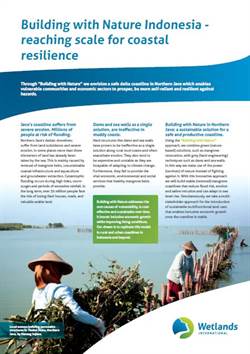
Bottom up in Indonesia!
-
Coastal resilience
-
Coastal wetland conservation
Last week, I visited Indonesia together with Femke Tonneijck from Wetlands International to meet our partners that are involved in the development of a Building with Nature approach to solve the severe erosion along the muddy Northern coast of Central Java (Demak district).
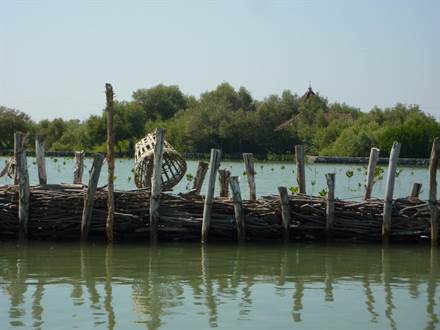 Deltares and Wetlands International have developed a small pilot project in the city Timbul Sloko that encompasses a few hundred meters of permeable wooden dams that catch fine sediment and therewith facilitate the restoration of mangroves (see figure and also blog Han Winterwerp that explains the ratio behind the dams in detail).
Deltares and Wetlands International have developed a small pilot project in the city Timbul Sloko that encompasses a few hundred meters of permeable wooden dams that catch fine sediment and therewith facilitate the restoration of mangroves (see figure and also blog Han Winterwerp that explains the ratio behind the dams in detail).
The results of the pilot are successful: >20 cm sedimentation in the first year and first pioneer mangroves popping-up.
As Ecoshape we aim to scale up the Building with Nature approach to other villages in the area such that the hinterland aquaculture that has been destroyed over the past five years can be rehabilitated. In addition we want to explore the potential of the concept for comparable coastlines in Indonesia and abroad.To make all this happen a broad range of expertise is required but also commitment and understanding at various organisational levels. During our meeting with our Indonesian partners in the following topics were highlighted.
Mangrove fingers
When looking from the air over the Demak area you see that the sea protrudes kilometers inland with high tide. Only near the rivers you see land covered by mangroves and houses that stick into the see as green fingers (figure). The small rivers supply sediment to the system and create elevated banks that are kept in place by mangroves and are the only safe places to live. Over the past 10 years the coastline has eroded back over more than a kilometer at several places. Villages have disappeared into the sea and inhabitants have moved land inward along the river where they usually have relatives.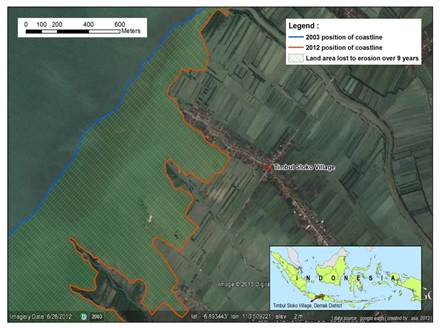
At the table in Timbul Sloko
During our visit to the city of Timbul Sloko we talked to the village head, village elders and administrators from Demak district. The local community is strongly committed to the pilot and contribute their own ideas, which they enthusiastically discussed with us but also amongst each other (see picture).
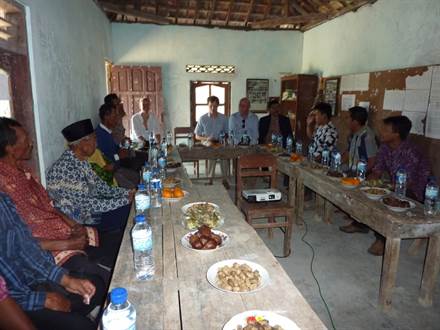
They agreed that land reclaimed from the sea with the permeable dams will not be exploited for aquaculture but instead will remain untouched such that mangroves can develop. In addition local fishermen inform each other to leave the permeable dams in place. The authorities even introduced a fine on permeable dam demolishment, but so far nobody was fined since the local community supports the initiative.
Also good to see the trust they have in Wetlands International expertise: “Femke, can we start with planting mangroves or should we wait?”. What I learned again from this meeting; mangrove restoration can only happen with bottom-up support!
Hard versus Soft
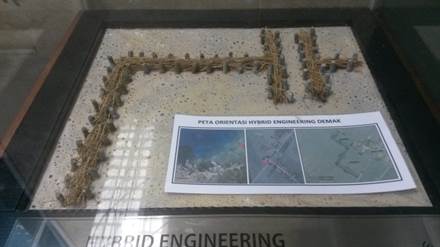 Talking to the district, provincial and national government of Indonesia they all see the potential of scaling up this concept to other locations. They promote the Building with Nature concept and at the office of the Ministry of Marine Affairs and Fisheries (MMAF) we even found a maquette of our pilot in Timbul Sloko (see picture).
Talking to the district, provincial and national government of Indonesia they all see the potential of scaling up this concept to other locations. They promote the Building with Nature concept and at the office of the Ministry of Marine Affairs and Fisheries (MMAF) we even found a maquette of our pilot in Timbul Sloko (see picture).
However getting more familiar with the Building with Nature approach they also understand that the permeable structures solution is designed for a muddy rural coast like Timbul Sloko. Upscaling the concept to other locations requires site specific adaptations on the layout and technical design of the permeable dams.In addition, for more urban environments, where space is limited, hard sea defenses will be needed but can be developed along the Building with Nature approach and can be integrated with soft solutions.They realise that upscaling the concept should be done with care and always be based on local understanding of the system. As part of the project they want to develop guidelines and concepts of the applicability and engineering of hard and soft solutions. In addition there is interest on how to shape the interface between a hard and soft sea defense.
Taskforce Integrated Coastal Zone Management
The Province of Central Java is already planning to secure the concept of Building with Nature in its policies for Integrated Coastal Zone Management. A Bappeda led taskforce explores opportunities for Building with Nature (hybrid engineering) at other locations. They see plenty of these, but also run into situations that will require additional thinking. For example in Cilicap (South Central Java at the Indian Ocean)the local sediment accumulation is such so large that the local mangroves could not keep up and died.

